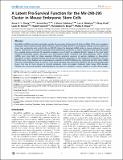A Latent Pro-survival Function for the Mir-290-295 Cluster in Mouse Embryonic Stem Cells
Author(s)
Ravi, Arvind; Calabrese, J. Mauro; Medeiros, Lea Ann; Kirak, Oktay; Dennis, Lucas M.; Jaenisch, Rudolf; Sharp, Phillip A.; Zheng, Xinying Grace; Burge, Christopher B; ... Show more Show less
DownloadBurge_A Latent.pdf (786.4Kb)
PUBLISHER_CC
Publisher with Creative Commons License
Creative Commons Attribution
Terms of use
Metadata
Show full item recordAbstract
MicroRNAs (miRNAs) post-transcriptionally regulate the expression of thousands of distinct mRNAs. While some regulatory interactions help to maintain basal cellular functions, others are likely relevant in more specific settings, such as response to stress. Here we describe such a role for the mir-290-295 cluster, the dominant miRNA cluster in mouse embryonic stem cells (mESCs). Examination of a target list generated from bioinformatic prediction, as well as expression data following miRNA loss, revealed strong enrichment for apoptotic regulators, two of which we validated directly: Caspase 2, the most highly conserved mammalian caspase, and Ei24, a p53 transcriptional target. Consistent with these predictions, mESCs lacking miRNAs were more likely to initiate apoptosis following genotoxic exposure to gamma irradiation or doxorubicin. Knockdown of either candidate partially rescued this pro-apoptotic phenotype, as did transfection of members of the mir-290-295 cluster. These findings were recapitulated in a specific mir-290-295 deletion line, confirming that they reflect miRNA functions at physiological levels. In contrast to the basal regulatory roles previously identified, the pro-survival phenotype shown here may be most relevant to stressful gestations, where pro-oxidant metabolic states induce DNA damage. Similarly, this cluster may mediate chemotherapeutic resistance in a neoplastic context, making it a useful clinical target.
Date issued
2011-05Department
Whitaker College of Health Sciences and Technology; Harvard University--MIT Division of Health Sciences and Technology; Massachusetts Institute of Technology. Computational and Systems Biology Program; Massachusetts Institute of Technology. Department of Biology; Koch Institute for Integrative Cancer Research at MITJournal
PLoS Genetics
Publisher
Public Library of Science
Citation
Zheng, Grace X. Y. et al. “A Latent Pro-Survival Function for the Mir-290-295 Cluster in Mouse Embryonic Stem Cells.” Ed. Michael T. McManus. PLoS Genetics 7.5 (2011) : e1002054.
Version: Final published version
ISSN
1553-7404
1553-7390